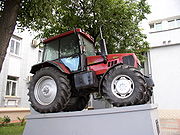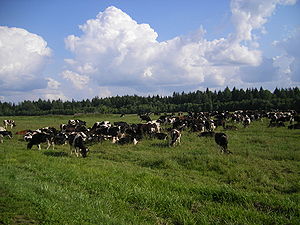
Agriculture in Belarus
Encyclopedia

Belarus
Belarus , officially the Republic of Belarus, is a landlocked country in Eastern Europe, bordered clockwise by Russia to the northeast, Ukraine to the south, Poland to the west, and Lithuania and Latvia to the northwest. Its capital is Minsk; other major cities include Brest, Grodno , Gomel ,...
ian economy. The share of agriculture in GDP declined from 11.6% in 2000 to 7.4% in 2007, while the share of agriculture in total employment dropped from 14.1% to 9.9% over the same period. The decrease in agricultural employment is a long-term trend and back in the early 1990s agriculture's share was as high as 19% of the number of employed. The decrease of agricultural labor parallels the general urbanization trends, as the share of rural population in Belarus
Demographics of Belarus
The Demographics of Belarus is about the demographic features of the population of Belarus, including population growth, population density, ethnicity, education level, health, economic status, religious affiliations, and other aspects of the population...
steadily declines over time.
Agricultural production

Belarus's main agricultural products are barley
Barley
Barley is a major cereal grain, a member of the grass family. It serves as a major animal fodder, as a base malt for beer and certain distilled beverages, and as a component of various health foods...
, rye
Rye
Rye is a grass grown extensively as a grain and as a forage crop. It is a member of the wheat tribe and is closely related to barley and wheat. Rye grain is used for flour, rye bread, rye beer, some whiskeys, some vodkas, and animal fodder...
, oat
Oat
The common oat is a species of cereal grain grown for its seed, which is known by the same name . While oats are suitable for human consumption as oatmeal and rolled oats, one of the most common uses is as livestock feed...
s, and wheat
Wheat
Wheat is a cereal grain, originally from the Levant region of the Near East, but now cultivated worldwide. In 2007 world production of wheat was 607 million tons, making it the third most-produced cereal after maize and rice...
, as well as potato
Potato
The potato is a starchy, tuberous crop from the perennial Solanum tuberosum of the Solanaceae family . The word potato may refer to the plant itself as well as the edible tuber. In the region of the Andes, there are some other closely related cultivated potato species...
es, flax
Flax
Flax is a member of the genus Linum in the family Linaceae. It is native to the region extending from the eastern Mediterranean to India and was probably first domesticated in the Fertile Crescent...
, rapeseed
Rapeseed
Rapeseed , also known as rape, oilseed rape, rapa, rappi, rapaseed is a bright yellow flowering member of the family Brassicaceae...
, and sugarbeets. Cereals and legumes (mainly barley and rye) take up 41% of sown area and another 43% is under crops used for animal feed. Potatoes and vegetables take up 11% of sown area and industrial crops (sugarbeets, flax, and some rapeseed) the remaining 4%. Products of animal origin are mainly pork
Pork
Pork is the culinary name for meat from the domestic pig , which is eaten in many countries. It is one of the most commonly consumed meats worldwide, with evidence of pig husbandry dating back to 5000 BC....
, beef
Beef
Beef is the culinary name for meat from bovines, especially domestic cattle. Beef can be harvested from cows, bulls, heifers or steers. It is one of the principal meats used in the cuisine of the Middle East , Australia, Argentina, Brazil, Europe and the United States, and is also important in...
, and poultry
Poultry
Poultry are domesticated birds kept by humans for the purpose of producing eggs, meat, and/or feathers. These most typically are members of the superorder Galloanserae , especially the order Galliformes and the family Anatidae , commonly known as "waterfowl"...
. Belarus has about 1.5 million cows, but the milk yields are relatively low (less than 3,000 kg per cow per year).
Changing farm structure
Belarus is generally characterized as a slow reformerLand reform
[Image:Jakarta farmers protest23.jpg|300px|thumb|right|Farmers protesting for Land Reform in Indonesia]Land reform involves the changing of laws, regulations or customs regarding land ownership. Land reform may consist of a government-initiated or government-backed property redistribution,...
compared to other CIS countries
Commonwealth of Independent States
The Commonwealth of Independent States is a regional organization whose participating countries are former Soviet Republics, formed during the breakup of the Soviet Union....
. Nevertheless, the share of traditional collective
Kolkhoz
A kolkhoz , plural kolkhozy, was a form of collective farming in the Soviet Union that existed along with state farms . The word is a contraction of коллекти́вное хозя́йство, or "collective farm", while sovkhoz is a contraction of советское хозяйство...
and state farms in agricultural land
Agricultural land
Agricultural land denotes the land suitable for agricultural production, both crops and livestock. It is one of the main resources in agriculture...
decreased from 94% in 1991 to 83% in 2004 as nearly 1 million hectares moved to family farms in the process of transition
Transition economy
A transition economy or transitional economy is an economy which is changing from a centrally planned economy to a free market. Transition economies undergo economic liberalization, where market forces set prices rather than a central planning organization and trade barriers are removed,...
reforms. The share of family farm
Family farm
A family farm is a farm owned and operated by a family, and often passed down from generation to generation. It is the basic unit of the mostly agricultural economy of much of human history and continues to be so in developing nations...
s in agricultural output increased from less than 25% in 1990 to 40%-50% in the 2000s. The number of so-called peasant farms, which began to emerge alongside the traditional household plot
Household plot
Household plot is a legally defined farm type in all former socialist countries in CIS and CEE. This is a small plot of land attached to a rural residence. The household plot is primarily cultivated for subsistence and its traditional purpose since the Soviet times has been to provide the family...
s since 1991, reached 2,500 in 2004 with average size of 72 hectares (compared with less than 1 hectare for the average household plot). The number of collective and state farms did not change much, decreasing from 2,500 in 1990 to 2,250 in 2003, but the average farm became much smaller, shedding half the labor force between 1990 and 2003 (from 896 workers per farm in 1990 to 463 in 2003). Agricultural land remains state-owned, as it was in the Soviet Union
Soviet Union
The Soviet Union , officially the Union of Soviet Socialist Republics , was a constitutionally socialist state that existed in Eurasia between 1922 and 1991....
, except for the land in the small household plots that has been privatized by special legislation.
There have been no major shifts in the number of animals between collective and family farms since independence: the family farm sector (mainly household plots) controlled 11%-16% of the total cattle herd and 30%-40% of the number of pigs between 1980 and 2005. Poultry, on the other hand, has become concentrated to a greater extent in collective farms, with the share of family farms dropping from more than 40% in the 1980s to less than 30% since 1995.

